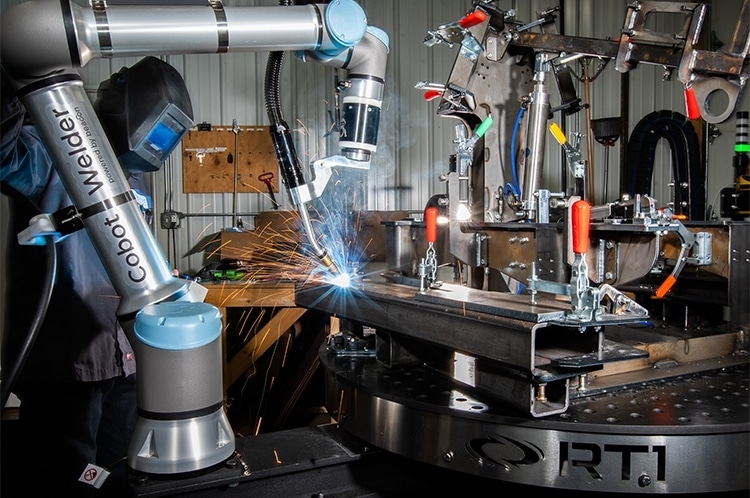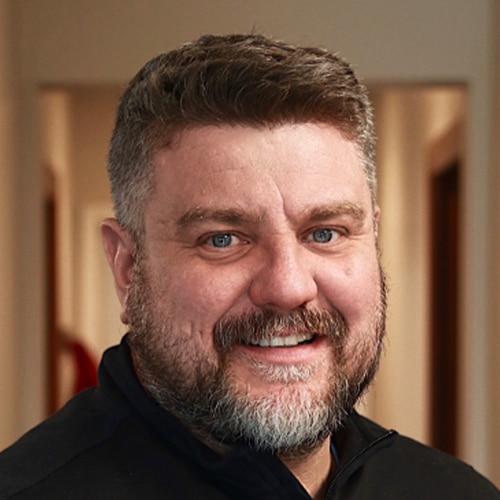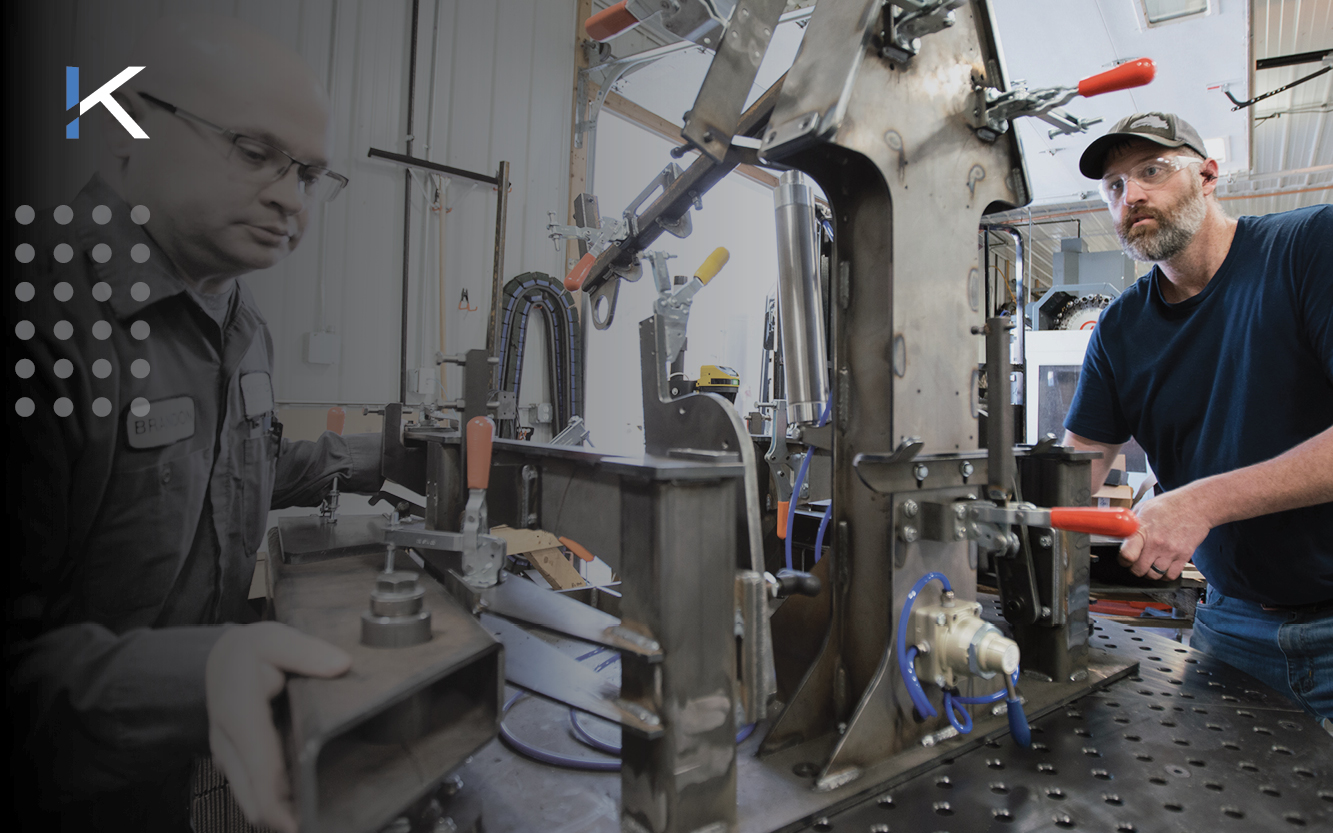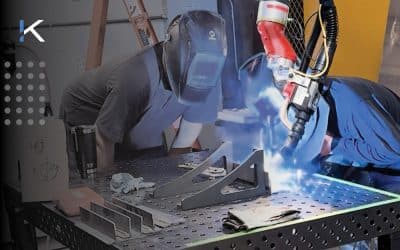Welding fixtures play a vital role in manufacturing and operations. They help you automate processes, ensure accuracy and repeatability, reduce scrap rates, improve quality control, and maximize productivity. When building welding fixtures, the first step is often to decide on the type of fixture to be designed. To streamline your decision-making process, let’s delve into the various types of welding fixtures that can revolutionize your operations. Understanding these options will equip you with the knowledge to make an educated decision, whether you decide to build your own or outsource the task to dedicated experts.
How To Classify Welding Fixtures
At Kinetic Technologies, we have a unique approach to classifying welding fixtures. We look at how the part, robot, and fixture work together. We don’t classify our fixtures based on the welding process (e.g., arc welding fixtures, laser welding fixtures), we look at the characteristics of the torch and how it will interact with the fixture. In other words, we look at it from the robot’s standpoint, not from the weld process. The fixture is designed in a way that ensures the tolerance, tightness, and repeatability remain consistent, with the robot repeatability being the driver for the fixture tolerances. This approach ensures that regardless of the size of the weld tolerance, the desired repeatability is maintained.

It’s our belief that this way of thinking can lead to a more effective and efficient manufacturing process, as it tailors the fixture to the operational requirements rather than the other way around. But with so many different types of welding fixtures out there, which one is right for your operation? Let’s take a look at some of the most popular welding fixture types as we define it at Kinetic Technologies.
Types of Welding Fixtures
One of the key factors to consider when designing your fixture is the clamping technology. Fixtures can be designed with a manual clamping system, where red-handled clamps are used to lock parts in place. This type requires an operator to lock or unlock the clamps during the process. Some more complex assemblies with small parts may require that you clamp and unclamp during the welding program. This helps when we want more accessibility to the assembly. For example, if you clamp a small part in the fixture, and tack weld it, then you might want to remove the clamp to be able to complete the full weld on that part. This is when semi-automatic or automatic clamping systems come into play. The robot can then send the signal to unclamp the part and continue its program without an operator’s intervention. This usually improves the cycle time and reduces downtime. For our team, we design these types of fixtures:
- Manual clamping fixtures
- Semi-automatic clamping fixtures (hybrid)
- Automatic clamping fixtures

Components of Welding Fixtures
Welding fixtures are composed of various components that work together to ensure the proper positioning and holding of the workpiece. Let’s take a closer look at some of these components:
- Base frame: The base frame serves as the foundation of the fixture, providing stability and support for the positioning system and workpiece.
- Clamping mechanisms: Clamping mechanisms are designed to secure the workpiece in place during welding operations. They can range from manual clamping using handle clamps to more advanced pneumatic clamping for automation purposes.
- Accessory pieces: Accessory pieces are additional components added to the fixture to support specific workpiece requirements. This can include mechanisms for maintaining runout on collars, small part holders, or specialized clamps to accommodate unique workpiece shapes or sizes.
- Zero frame or origin point: The zero frame or origin point is an essential component that helps establish the reference point for positioning the workpiece. It assists in maintaining consistency and accuracy throughout the welding process.
Welding Fixtures Design Tips
A fixture is only as good as its design. Here are a few tips to keep in mind when designing your welding fixture:
- A good welding fixture ensures secure and stable positioning of the product during welding, while also allowing for easy removal after welding.
- Take into account the heat effects of the welding process on the finished part.
- Fabricate fixtures with removable stops and easy-to-replace parts so that you do not have to replace the entire fixture when certain areas wear out.
- Design your fixtures with the welding robot in mind. They have specific ranges of movement, and the fixture must be designed to accommodate these limitations.
- To prevent arcing and potential damage to the fixture or robot, it is important to properly ground the fixture.
- Design your fixtures with safety in mind. They should create a safer environment and be easy to use.
The Cost of Welding Fixtures
When it comes to welding fixtures, cost can vary based on factors such as complexity and size. While it is challenging to provide an exact cost range without specific details, we can categorize welding fixtures into simpler and more complex ranges based on general observations. But remember that each fixture is unique, with no one-size-fits-all price.
- Simple fixtures with manual clamping: These fixtures are typically designed for straightforward parts and involve manual clamping using red handle clamps. The cost for such fixtures usually starts around $15,000.
- More complex fixtures with automation elements: As the complexity of the fixture increases, along with the size and weight of the parts, additional design considerations and automation elements may be required. These fixtures can range up to $50,000, depending on the specific requirements and customization.
Customers might choose to save by making their own fixtures, but the main cost drivers are the fixture’s engineering design and, for larger parts, the need for extra materials to support weight and balanced rotation.
Get the Right Type of Fixtures With Kinetic Technologies
We understand that welding fixture design can be a complex and time-consuming process, and our team is here to make it as easy as possible.

By outsourcing the design and fabrication of welding fixtures and positioners to a trusted partner like Kinetic Technologies, you can save time and money while ensuring that your fixtures are built correctly the first time. Our team of experienced engineers and technicians can work with you to create a custom fixture or positioner that is tailored to meet the needs of your operations. With Kinetic Technologies, you’re not just improving your process; you’re investing in the future of your business. Let’s discuss your welding fixture needs.
FAQs About Types of Fixtures
What Are Jigs and Fixtures in Welding?
Jigs and fixtures are an integral part of welding operations. They are used to hold components in place during the welding process, allowing for precise and consistent welds. Jigs are typically more basic than fixtures, while fixtures often have more complex designs that allow for a greater degree of movement or customization. The use of jigs and fixtures helps ensure that welds are made with the highest level of accuracy and repeatability. This is especially important for welding operations involving complex parts or intricate designs.
What Are Common Examples of Fixtures?
Common examples of fixtures include: welding positioners, rotators, manipulators, and turn tables. Welding positioners allow for adjustable positioning of components during the weld process to ensure accurate results. Rotators enable full 360° rotation of a component or assembly. Manipulators provide precise control over the movement of parts through three axes – up/down, side-to-side, and rotational. Lastly, turn-tables provide additional rotation of components to facilitate complex welding operations.
What Is the Most Common Type of Fixture?
The most common type of fixture in the welding industry is typically classified based on the welding process types. However, as explained in this article, Kinetic Technologies takes a different approach. We have realized that for robotic welding, what matters the most is the repeatability of the robot. Therefore, we prioritize ensuring that the tolerances remain the same regardless of the welding process used. This unique perspective sets Kinetic Technologies apart from other companies in the industry.

Mark Barglof is the President and owner of Kinetic Technologies, LLC, a robotic welding integration shop just north of Algona, IA. After serving in the military and earning the U.S. Army Ranger Tab, Mark shifted career paths and dove into the world of manufacturing. His vision is to build a full-service engineering and robotics company that can bring to bear all the advanced engineering tools to support their clients and make their concepts come to life quickly. They are intently focused on robotic welding integrations, robotic welding positioners and fixtures, and custom machine building.




